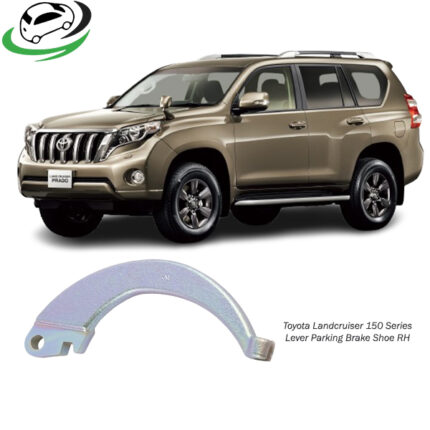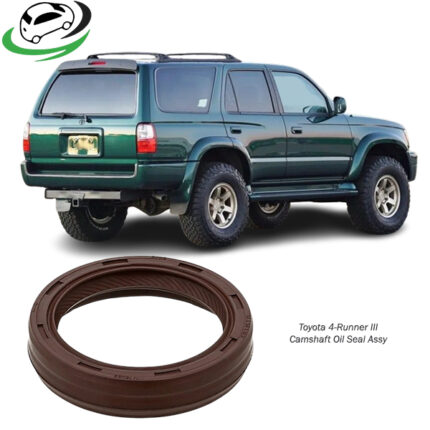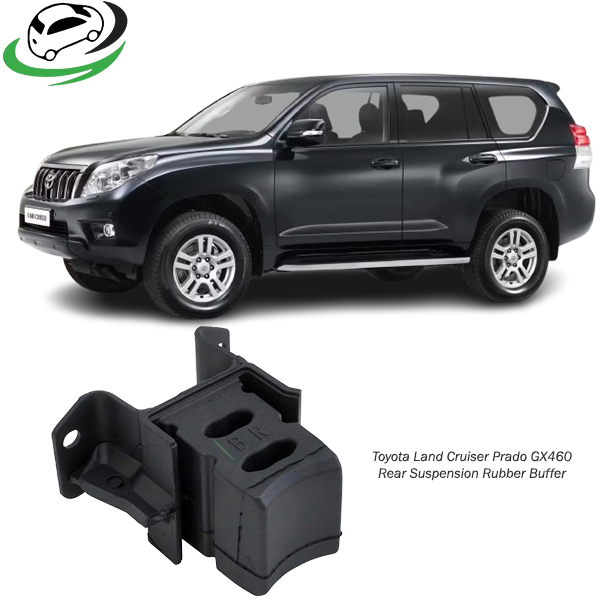-7%
Get Toyota Land Cruiser Prado GX460 Genuine Bumper Sub-Assy, Rear Spring, RH 48306-60240
The genuine bumper sub-assembly for the rear spring (right-hand side) is a crucial component in a vehicle’s suspension and body structure. It plays a significant role in maintaining the integrity of the vehicle, ensuring safety, and providing comfort to passengers. This guide covers its purpose, design and construction, benefits, installation process, maintenance tips, and signs of wear.
1. Purpose of the Rear Spring Bumper Sub-Assembly
The primary purpose of the rear spring bumper sub-assembly is to provide support and cushioning for the rear suspension system. It acts as a buffer between the vehicle’s body and the axle, absorbing shocks from road irregularities and enhancing ride quality.
a. Shock Absorption
When driving over bumps or potholes, the rear spring bumper helps absorb the impact, preventing excessive movement of the vehicle’s body. This function enhances comfort for passengers and helps maintain control of the vehicle.
b. Protection of Suspension Components
The bumper sub-assembly helps protect critical suspension components, such as the rear springs, shock absorbers, and other related parts. By minimizing the impact of road irregularities, it helps extend the lifespan of these components.
c. Stability and Handling
A properly functioning rear spring bumper contributes to the overall stability and handling of the vehicle. It helps maintain the alignment of the rear suspension, ensuring that the tires maintain optimal contact with the road.
2. Design and Construction of the Rear Spring Bumper Sub-Assembly
The genuine rear spring bumper sub-assembly is designed to withstand significant stress and wear. Understanding its components and materials can provide insight into its functionality and durability.
a. Material Composition
Typically, the bumper sub-assembly is made from high-quality rubber or polyurethane. These materials are chosen for their resilience and ability to absorb shocks effectively while maintaining structural integrity.
b. Design Features
- Shape and Size: The bumper is designed to fit snugly between the axle and the vehicle’s body, providing adequate cushioning for the suspension system. Its shape may vary depending on the vehicle’s make and model, ensuring proper fitment.
- Mounting Points: The sub-assembly includes specific mounting points designed for easy installation and secure attachment to the vehicle. These points are engineered to withstand the forces experienced during driving.
- Spring Support: The bumper sub-assembly often incorporates features that support the rear spring, providing additional stability and preventing lateral movement during operation.
c. Quality Assurance
Genuine parts, such as the bumper sub-assembly, undergo rigorous quality assurance testing to ensure they meet OEM (Original Equipment Manufacturer) specifications. This ensures compatibility, performance, and durability.
3. Benefits of Using a Genuine Rear Spring Bumper Sub-Assembly
Investing in a genuine bumper sub-assembly for the rear spring offers numerous advantages that contribute to vehicle performance and safety.
a. Enhanced Ride Comfort
A genuine bumper sub-assembly is designed to absorb shocks and vibrations effectively, leading to a smoother and more comfortable ride for passengers. It minimizes the impact of road irregularities on the vehicle’s body.
b. Improved Safety
By maintaining proper suspension alignment and performance, a genuine rear spring bumper helps improve vehicle safety. It reduces the risk of handling issues or loss of control during driving, especially in challenging conditions.
c. Increased Durability
Genuine parts are manufactured to strict standards, ensuring they withstand wear and tear over time. This durability leads to longer service life and fewer replacement needs compared to non-genuine alternatives.
d. Seamless Compatibility
Using a genuine bumper sub-assembly ensures seamless compatibility with the vehicle’s suspension system. This compatibility contributes to better performance and reduces the risk of installation issues.
4. Installation Process of the Rear Spring Bumper Sub-Assembly
Installing the rear spring bumper sub-assembly requires mechanical knowledge and proper tools. Here’s a step-by-step guide to assist in the installation process:
a. Tools Required
Before beginning the installation, gather the necessary tools:
- Jack and jack stands
- Wrench set
- Socket set
- Torque wrench
- Screwdrivers
- Lubricant
- Safety goggles and gloves
b. Preparation
- Safety First: Park the vehicle on a level surface, engage the parking brake, and ensure the engine is off. Wear safety goggles and gloves throughout the process.
- Lift the Vehicle: Use a jack to lift the rear of the vehicle and secure it with jack stands. This step is crucial for safely accessing the rear suspension components.
c. Remove the Wheel
- Loosen Lug Nuts: Use a lug wrench to slightly loosen the lug nuts on the rear wheel before removing the wheel completely.
- Remove the Wheel: Take off the wheel to expose the rear suspension and bumper assembly.
d. Remove the Old Rear Spring Bumper Sub-Assembly
- Inspect the Suspension: Before removing the old bumper sub-assembly, inspect the surrounding components for wear or damage.
- Locate Mounting Points: Identify the mounting points of the old bumper sub-assembly.
- Remove Fasteners: Use the appropriate wrench or socket to remove any bolts or fasteners securing the old bumper in place.
- Remove the Old Bumper: Carefully detach the old bumper from its mounting points and remove it from the vehicle.
e. Install the New Rear Spring Bumper Sub-Assembly
- Position the New Bumper: Align the new bumper sub-assembly with the mounting points on the vehicle.
- Secure with Fasteners: Reinsert and tighten the bolts or fasteners to secure the new bumper in place. Use a torque wrench to ensure the fasteners are tightened to the manufacturer’s specifications.
- Check Alignment: Ensure that the new bumper is properly aligned and seated correctly.
f. Reinstall the Wheel and Lower the Vehicle
- Reinstall the Wheel: Place the wheel back on and hand-tighten the lug nuts.
- Lower the Vehicle: Carefully lower the vehicle off the jack stands using the jack.
- Tighten Lug Nuts: Use a torque wrench to tighten the lug nuts to the manufacturer’s specifications.
g. Test the Installation
- Check for Proper Function: After installation, conduct a visual inspection to ensure all components are secure and properly aligned.
- Test Drive the Vehicle: Take the vehicle for a short test drive to ensure that the rear suspension functions smoothly and effectively.
5. Maintenance Tips for the Rear Spring Bumper Sub-Assembly
Proper maintenance of the rear spring bumper sub-assembly is essential for ensuring optimal performance and longevity. Here are some maintenance tips:
a. Regular Inspections
Conduct regular inspections of the rear suspension components, including the bumper sub-assembly. Look for signs of wear, such as cracks, tears, or deformities in the bumper material.
b. Listen for Noises
Be attentive to any unusual noises coming from the rear suspension while driving. Squeaks or rattles may indicate that the bumper or other components need attention.
c. Monitor Vehicle Performance
Pay attention to changes in ride quality or handling characteristics. If the vehicle feels unstable or bouncy, it may indicate a problem with the rear suspension, including the bumper.
d. Keep It Clean
Regularly clean the area around the rear suspension and bumper to prevent dirt and debris accumulation. This maintenance can help identify any potential issues early.
e. Replace When Necessary
If inspections reveal significant wear or damage, replace the bumper sub-assembly promptly. Ignoring worn components can lead to decreased performance and increased risk of accidents.
6. Signs of Wear and When to Replace
Understanding the signs of wear is crucial for maintaining safety and performance. Here are some common indicators that the rear spring bumper sub-assembly may need replacement:
a. Cracking or Splitting
Visible cracks or splits in the bumper material indicate that it is deteriorating and may need replacement to ensure effective shock absorption.
b. Excessive Wear
If the bumper appears excessively worn or deformed, it is likely time for a replacement. Worn bumpers can lead to compromised suspension performance.
c. Reduced Ride Comfort
If you notice a significant decrease in ride comfort or an increase in noise and vibrations while driving, it may be a sign that the bumper is no longer functioning effectively.
d. Misalignment of Suspension Components
If the rear suspension appears misaligned or the vehicle exhibits uneven wear on tires, it may indicate a problem with the bumper or related components.
e. Fluid Leaks
If you notice any fluid leaks near the rear suspension, it may indicate a failure in the suspension system. Inspect the bumper and surrounding components for damage.
Conclusion
The genuine bumper sub-assembly for the rear spring (right-hand side) is a vital component that contributes to the safety, comfort, and performance of a vehicle. Understanding its purpose, construction, benefits, installation process, maintenance, and signs of wear can help vehicle owners make informed decisions about their rear suspension systems. Regular inspections, timely replacements, and the use of genuine parts are essential for ensuring optimal performance and safety on the road. Prioritize the maintenance of your vehicle’s rear spring bumper sub-assembly to enjoy a safe and smooth driving experience.
Follow us on Facebook for more parts.




Reviews
Clear filtersThere are no reviews yet.